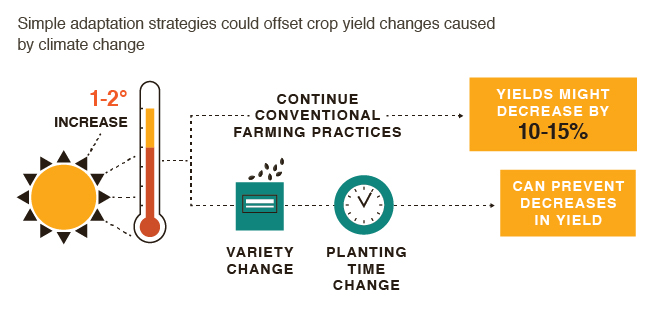Forests and Landscapes

Facts
- Forest and tree ecosystem services are often largely overlooked and undervalued, but will become increasingly important for human adaptation to climate change. If we are to get the best out of these services we need to understand them better, ways to maintain and enhance them and policies to support their delivery (FAO 2013 p. 239).
- We do not know the extent of the adaptive capacity of forests, but they are generally able to withstand some levels of climatic stress, especially intact forests. However, there is concern that the adaptive capacity of forests will not be sufficient to adapt to the unprecedented rates of climate change foreseen (Locatelli et al. 2008 p. 6).
- There is a wide array of technical measures to enhance the adaptive capacity of forest plantations, because these ecosystems are generally intensively managed and the management can be modified to adapt to climate change. For instance, species and genotypes can be selected based on expected future climates, while planting a mix of species and maintaining an uneven age structure can increase resistance or resilience or harvesting can be brought forward to reduce losses from impending climate change (Locatelli et al. 2008 p. 11)
- Other adaptation strategies suggested for planted forests include: changes in management intensity, hardwood/softwood species mix, timber growth and harvesting patterns within and between regions; changing rotation periods; salvaging dead timber; shifting to species or areas more productive under the new climatic conditions; landscape planning to minimize fire and insect damage; adjusting to altered wood size and quality; and adjusting fire-management systems (Easterling et al. 2007 p. 295)
- Agroforestry (trees on farms) can increase soil fertility, reduce soil erosion and provide other environmental benefits, helping farmers deal with increased climate variability (Thorlakson and Neufeldt 2012).
- National policy should encourage adaptive management of forests. At the same time, it should promote forests for adaptation—recognizing the role of forests in reducing societal vulnerability and including all stakeholders who benefit from forest ecosystem services in planning and implementing forest adaptation efforts (Locatelli et al. 2008 p. 43).
- In particular, protecting and replanting mangrove forest can protect against coastal impacts of climate change. For example, in Bangladesh mangrove forest acts as an effective protective buffer against the impacts of cyclones and storm surges (Rawlani and Sovacool 2011).
- Agroforestry systems offer many opportunities for improving resilience in smallholder farming settings through increasing income diversity. Furthermore, the increased flow of products arising from additional tree sources (i.e. timber, fuelwood, fodder or fruits) enhances livelihood security upon unexpected economic shocks (Verchot et al. 2007; Lasco et al. 2014).
Sources and further reading
- Easterling WE, Aggarwal PK, Batima P, Brander KM, Erda L, Howden SM, Kirilenko A, Morton J, Soussana JF, Schmidhuber J, Tubiello FN. 2007. Food, fibre and forest products. In: Parry ML, Canziani OF, Palutikof JP, van der Linden PJ, Hanson CE, eds. Climate change 2007: Impacts, adaptation and vulnerability. Contribution of Working Group II to the Fourth Assessment Report of the Intergovernmental Panel on Climate Change. Cambridge, UK: Cambridge University Press. pp. 273–313. (Available from https://www.ipcc.ch/pdf/assessment-report/ar4/wg2/ar4-wg2-chapter5.pdf)
- [FAO] Food and Agriculture Organization of the United Nations. 2013. Climate-smart agriculture sourcebook. Rome: Food and Agriculture Organization of the United Nations. (Available from http://www.fao.org/docrep/018/i3325e/i3325e.pdf) (Accessed on 5 November 2013)
- Lasco RD, Delfino RJP, Espaldon MLO. 2014. Agroforestry systems: helping smallholders adapt to climate risks while mitigating climate change. Wiley Interdisciplinary Reviews: Climate Change 5:825-833. http://dx.doi.org/10.1002/wcc.301
- Locatelli B, Kanninen M, Brockhaus M, Colfer CJP, Murdiyarso D, Santoso H. 2008. Facing an uncertain future: How forests and people can adapt to climate change. Forest Perspectives no. 5. Bogor, Indonesia: Center for International Forestry Research. (Available from http://www.cifor.org/publications/pdf_files/media/CIFOR_adaptation.pdf)
- Rawlani AK, Sovacool BK. 2011. Building responsiveness to climate change through community based adaptation in Bangladesh. Mitigation and Adaptation Strategies for Global Change 16(8):845–863. (Available from http://dx.doi.org/10.1007/s11027-011-9298-6)
- Thorlakson T, Neufeldt H. 2012. Reducing subsistence farmers' vulnerability to climate change: evaluating the potential contributions of agroforestry in western Kenya. Agriculture & Food Security 2012, 1:15. (Available from http://dx.doi.org/10.1186/2048-7010-1-15)
- Verchot LV, Van Noordwijk M, Kandji S, Tomich T, Ong C, Albrecht A, Mackensen J, Bantilan C, Anupama KV, Palm C. 2007. Climate change: linking adaptation and mitigation through agroforestry. Mitigation and adaptation strategies for global change 12:901-918. http://dx.doi.org/10.1007/s11027-007-9105-6